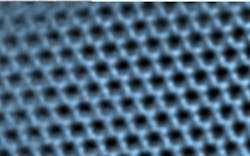2D iron-ore material hematene improves solar-fuel generation potential
In the wake of its recent discovery of a flat form of gallium, an international team led by scientists from Rice University has created another two-dimensional (2D) material that the researchers said could be a game changer for solar fuel generation. Rice materials scientist Pulickel Ajayan and colleagues extracted 3-atom-thick hematene from common iron ore. The research was introduced in a paper in Nature Nanotechnology.
RELATED ARTICLE: Optofluidics assists solar fuel generation
Hematene may be an efficient photocatalyst, especially for splitting water into hydrogen and oxygen, and could also serve as an ultrathin magnetic material for spintronic-based devices, the researchers said.
Ajayan's lab worked with researchers at the University of Houston and in India, Brazil, Germany and elsewhere to exfoliate the material from naturally occurring hematite using a combination of sonication, centrifugation and vacuum-assisted filtration. Hematite was already known to have photocatalytic properties, but they are not good enough to be useful, the researchers said.
"For a material to be an efficient photocatalyst, it should absorb the visible part of sunlight, generate electrical charges and transport them to the surface of the material to carry out the desired reaction," said Oomman Varghese, a co-author and associate professor of physics at the University of Houston. "Hematite absorbs sunlight from ultraviolet to the yellow-orange region, but the charges produced are very short-lived. As a result, they become extinct before they reach the surface," he said.
Hematene photocatalysis is more efficient because photons generate negative and positive charges within a few atoms of the surface, the researchers said. By pairing the new material with titanium dioxide nanotube arrays, which provide an easy pathway for electrons to leave the hematene, the scientists found they could allow more visible light to be absorbed.
The researchers also discovered that hematene's magnetic properties differ from those of hematite. While native hematite is antiferromagnetic, tests showed that hematene is ferromagnetic, like a common magnet. "Most 2D materials to date have been derived from bulk counterparts that are layered in nature and generally known as van der Waals solids," said co-author professor Anantharaman Malie Madom Ramaswamy Iyer of the Cochin University of Science and Technology, India. "2D materials from bulk precursors having (non-van der Waals) 3D bonding networks are rare, and in this context hematene assumes great significance."
SOURCE: Rice University; http://news.rice.edu/2018/05/07/hematene-joins-parade-of-new-2-d-materials/
About the Author

Gail Overton
Senior Editor (2004-2020)
Gail has more than 30 years of engineering, marketing, product management, and editorial experience in the photonics and optical communications industry. Before joining the staff at Laser Focus World in 2004, she held many product management and product marketing roles in the fiber-optics industry, most notably at Hughes (El Segundo, CA), GTE Labs (Waltham, MA), Corning (Corning, NY), Photon Kinetics (Beaverton, OR), and Newport Corporation (Irvine, CA). During her marketing career, Gail published articles in WDM Solutions and Sensors magazine and traveled internationally to conduct product and sales training. Gail received her BS degree in physics, with an emphasis in optics, from San Diego State University in San Diego, CA in May 1986.
